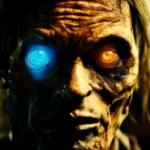
Galleries everywhere are awash during these brand-name reductivist canvases, all pretty much handsome, harmless, supposedly metacritical, and merely “new” or “dangerous”-searching enough to not violate anyone’s feeling of what “new” or “dangerous” is really, everything impersonal, mimicking some preapproved influences. (It is also a worldwide presence: I saw scads from it in Berlin a couple of days back, and art fairs are inundated.) These artists are acting like hands on junior postmodernist worker bees, attempting to crawl in to the body of and imitate the great past of abstraction, deploying visual signals of Suprematism, color-field painting, minimalism, publish-minimalism, Italian Arte Povera, Japanese Mono-ha, process art, modified action painting, all gesturing toward guys like Polke, Richter, Warhol, Made of woll, Prince, Kippenberger, Albert Oehlen, Wade Guyton, Rudolf Stingel, Sergej Jensen, and Michael Krebber. I’ve photographed countless examples this season, at galleries and art fairs, along with a sampling seems on these pages.
The work is decorator-friendly, particularly in a modern day apartment or house. It feels “cerebral” and appears hip with techniques that flatter collectors even while it provides no understanding of anything more. It’s finished in haggard shades of pale, deployed in uninventive plans that ape digital media, or something like that homespun or dilapidated. Replete with self-conscious comments on art, recycling, sustainability, appropriation, processes of abstraction, or nature, all of this painting employs an identical vocabulary of smudges, stains, spray paint, flecks, spills, splotches, almost-monochromatic fields, silk-screening, or stenciling. Edge-to-edge, geometric, or biomorphic composition is de rigueur, much like irregular grids, lattice and moiré patterns, ovular shapes, and stripes, with maybe some collage. Many occasions, stretcher bars play a role. This should really inform us, “See, I understand I’m a painting—and I am not glitzy like something from Takashi Murakami and Shaun Koons.” Point about this method is just painters playing scales, doing finger exercises, with no wit or even the rapport which makes music. Rather, it’s visual Muzak, blending in.
Most Zombie Formalism comes to a vertical format, tailor-designed for instant digital distribution and viewing via jpeg on portable devices. It appears pretty very similar personally because it does on iPhone, iPad, Twitter, Tumblr, Pinterest, and Instagram. Collectors needn’t see shows of the work, because it offers so very little visual or material resistance. It’s little internal scale, and it is graphic field is drawn in at the same time. The thing is and obtain it fast, after which it doesn’t change. There aren’t any complex structural presences to assimilate, couple of surprises, with no unique visual iconographies or incongruities to be prepared for. It’s frictionless, designed for trade. Art as bitcoin.
Almost everybody who paints such as this originates through art school. Thus the job harks to the time these artists were trained to lionize, the supposedly purer times of the 1960s and 1970s, when their teachers’ views appeared to be created. Both students and teachers focus on that one specific period then only on one sort of art of the period then only on certain artists. It’s art-historic obvious-cutting, aesthetic monoculture without any aesthetic bio-diversity. This isn’t painting but semantic painterbation—what an unctuous auction catalogue, in mention of the one artist’s work, lately known as “established postmodern praxis.”
Apologists offer convoluted defenses, stating that certain practitioners vary from all of the others. Lucien Cruz uses fire extinguishers to create his little drips Dan Colen uses M&Ms for his Adam McEwen deploys gum Parker Ito paints fields of hazy colored dots. There are lots of artists who make art that appears printed but is hand crafted others allow it to be look hand crafted when it’s printed. We’re told that the painting is created by dicing other works of art, or it had become left outdoors or perhaps in a polluted lake or sent with the mail, or it originated from Tahrir Square. We hear the artist is “commenting on” commodity culture, global warming, social oppression, art history. One well-known curator attempted lately to warrant the splattered Julian Schnabel–Joe Bradley–Jean-Michel Basquiat manqué of Oscar Murillo—the hottest of these artists—by connecting his tarp- or tentlike surfaces to folks living under makeshift canvas shelters in Murillo’s native Colombia. Let alone he was educated in England and largely increased available online for. At 28, clearly gifted, Murillo’s still making his student work and may grow to be great. Regardless, a lot of consumers happen to be so committed to him that everyone’s attempting to cover their position. In a single trip to Frieze recently, three major art dealers pulled me aside to state that, even though they agreed that we’re awash in Crapstraction, their artist was “the real thing.Inches I told each dealer exactly what the other had stated in my experience, which each had named another hot artist.

I’ll admit which i don’t hate all this work. Frankly, I love a lot of it. The saddest thing about this trend is the fact that better still artists who paint by doing this are becoming lost within the onslaught of copycat mediocrity and mechanical art. Likely to galleries has become less like venturing into individual arks and much more like likely to retailers where everything looks familiar. My prediction is the fact that, assuming money disappears in the art market again, the underside will fall using this genericism. Everybody will instantly stop making the type of painting which was a solution to an issue that nobody remembers asking—and it should never be spoken about again.
*This short article seems within the June 16, 2014 issue of recent You are able to Magazine.
Resourse: http://vulture.com/2014/06/






